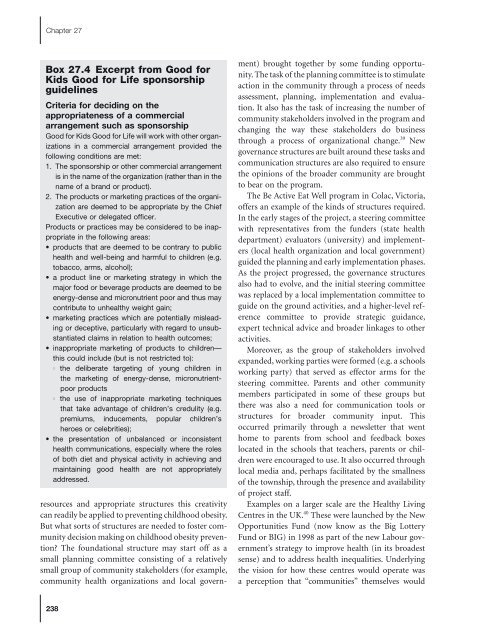Preventing Childhood Obesity - Evidence Policy and Practice.pdf
Preventing Childhood Obesity - Evidence Policy and Practice.pdf
Preventing Childhood Obesity - Evidence Policy and Practice.pdf
You also want an ePaper? Increase the reach of your titles
YUMPU automatically turns print PDFs into web optimized ePapers that Google loves.
Chapter 27<br />
Box 27.4 Excerpt from Good for<br />
Kids Good for Life sponsorship<br />
guidelines<br />
Criteria for d eciding on the<br />
a ppropriateness of a c ommercial<br />
a rrangement s uch a s s ponsorship<br />
Good for Kids Good for Life will work with other organizations<br />
in a commercial arrangement provided the<br />
following conditions are met:<br />
1. The sponsorship or other commercial arrangement<br />
is in the name of the organization (rather than in the<br />
name of a br<strong>and</strong> or product).<br />
2. The products or marketing practices of the organization<br />
are deemed to be appropriate by the Chief<br />
Executive or delegated officer.<br />
Products or practices may be considered to be inappropriate<br />
in the following areas:<br />
• products that are deemed to be contrary to public<br />
health <strong>and</strong> well - being <strong>and</strong> harmful to children (e.g.<br />
tobacco, arms, alcohol);<br />
• a product line or marketing strategy in which the<br />
major food or beverage products are deemed to be<br />
energy - dense <strong>and</strong> micronutrient poor <strong>and</strong> thus may<br />
contribute to unhealthy weight gain;<br />
• marketing practices which are potentially misleading<br />
or deceptive, particularly with regard to unsubstantiated<br />
claims in relation to health outcomes;<br />
• inappropriate marketing of products to children —<br />
this could include (but is not restricted to):<br />
<br />
the deliberate targeting of young children in<br />
the marketing of energy - dense, micronutrient -<br />
poor products<br />
<br />
the use of inappropriate marketing techniques<br />
that take advantage of children ’ s credulity (e.g.<br />
premiums, inducements, popular children ’ s<br />
heroes or celebrities);<br />
• the presentation of unbalanced or inconsistent<br />
health communications, especially where the roles<br />
of both diet <strong>and</strong> physical activity in achieving <strong>and</strong><br />
maintaining good health are not appropriately<br />
addressed.<br />
resources <strong>and</strong> appropriate structures this creativity<br />
can readily be applied to preventing childhood obesity.<br />
But what sorts of structures are needed to foster community<br />
decision making on childhood obesity prevention?<br />
The foundational structure may start off as a<br />
small planning committee consisting of a relatively<br />
small group of community stakeholders (for example,<br />
community health organizations <strong>and</strong> local govern-<br />
ment) brought together by some funding opportunity.<br />
The task of the planning committee is to stimulate<br />
action in the community through a process of needs<br />
assessment, planning, implementation <strong>and</strong> evaluation.<br />
It also has the task of increasing the number of<br />
community stakeholders involved in the program <strong>and</strong><br />
changing the way these stakeholders do business<br />
through a process of organizational change. 39 New<br />
governance structures are built around these tasks <strong>and</strong><br />
communication structures are also required to ensure<br />
the opinions of the broader community are brought<br />
to bear on the program.<br />
The Be Active Eat Well program in Colac, Victoria,<br />
offers an example of the kinds of structures required.<br />
In the early stages of the project, a steering committee<br />
with representatives from the funders (state health<br />
department) evaluators (university) <strong>and</strong> implementers<br />
(local health organization <strong>and</strong> local government)<br />
guided the planning <strong>and</strong> early implementation phases.<br />
As the project progressed, the governance structures<br />
also had to evolve, <strong>and</strong> the initial steering committee<br />
was replaced by a local implementation committee to<br />
guide on the ground activities, <strong>and</strong> a higher - level reference<br />
committee to provide strategic guidance,<br />
expert technical advice <strong>and</strong> broader linkages to other<br />
activities.<br />
Moreover, as the group of stakeholders involved<br />
exp<strong>and</strong>ed, working parties were formed (e.g. a schools<br />
working party) that served as effector arms for the<br />
steering committee. Parents <strong>and</strong> other community<br />
members participated in some of these groups but<br />
there was also a need for communication tools or<br />
structures for broader community input. This<br />
occurred primarily through a newsletter that went<br />
home to parents from school <strong>and</strong> feedback boxes<br />
located in the schools that teachers, parents or children<br />
were encouraged to use. It also occurred through<br />
local media <strong>and</strong>, perhaps facilitated by the smallness<br />
of the township, through the presence <strong>and</strong> availability<br />
of project staff.<br />
Examples on a larger scale are the Healthy Living<br />
Centres in the UK. 40 These were launched by the New<br />
Opportunities Fund (now know as the Big Lottery<br />
Fund or BIG) in 1998 as part of the new Labour government<br />
’ s strategy to improve health (in its broadest<br />
sense) <strong>and</strong> to address health inequalities. Underlying<br />
the vision for how these centres would operate was<br />
a perception that “ communities ” themselves would<br />
238

















